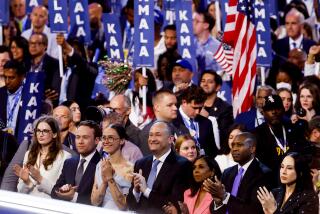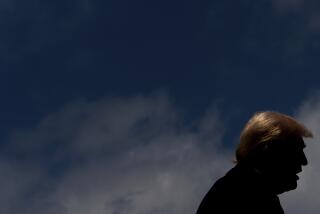There’s nothing up her sleeve, in fact
- Share via
In the classic film “She Done Him Wrong,” a dapper young Gilbert Roland encounters Mae West for the first time. “I’ve heard a lot about you,” he says. “Yeah,” she shoots back, “but you can’t prove it.”
Neither, it seems, can Kitty Kelley.
For the record:
12:00 a.m. Sept. 22, 2004 For The Record
Los Angeles Times Wednesday September 22, 2004 Home Edition Main News Part A Page 2 National Desk 2 inches; 77 words Type of Material: Correction
Kitty Kelley -- In some copies of the Tuesday Calendar section, a review of “The Family: The Real Story of the Bush Dynasty” said author Kitty Kelley wrote that President Bush gave up “tobacco, alcohol and drugs, at the age of forty” -- five years before he went to Camp David when his father was president. Bush turned 40 2 1/2 years before his father became president and two years after he himself became a born-again Christian.
From the beginning of “The Family: The Real Story of the Bush Dynasty,” Kelley strains at the leash and bares her teeth. Indeed, she makes her most incendiary charge before the first chapter, quick work even for an attack biography. Toward the end of her 10-page author’s note, she quotes Sharon Bush, the bitter ex-wife of President Bush’s brother Neil, saying that George W. Bush and his brother Marvin “did coke at Camp David when their father was President, and not just once either.” For good measure, Kelley repeats the cocaine allegation several hundred pages later, this time slightly amplified (“not once, but many times”) and again 200 pages beyond that. She also asserts that President Bush used cocaine as an undergraduate at Yale and when he served in the Texas National Guard.
If true, these are serious charges. But are they true? Based on the sources Kelley cites, it is impossible to know. Sharon Bush has since publicly denied making the allegation to Kelley, saying she never saw her former brothers-in-law engage in such activities. The author undermines the charge, perhaps inadvertently, when she states elsewhere that President Bush’s conversion to born-again Christianity in April 1984 “led George to give up tobacco, alcohol, and drugs at the age of forty” -- three years before he went to Camp David when his father was president. Kelley’s other sources are an unnamed Yale classmate, who supposedly told his tale to the writer Erica Jong; an unnamed Yale graduate student; “those who worked with George” on a political campaign in 1972; and retired 1st Lt. Robert A. Rogers, who served 11 years in the National Guard and has written about its procedures. Rogers speculates to Kelley that Bush may have ducked a physical examination during his military service in 1972 to avoid substance abuse detection. But Kelley has admitted that Rogers never met Bush and has no direct knowledge of Bush’s activities in the National Guard.
To understand a Kelley book, it is necessary to crack the code of her technique. She is not so much a biographer as an illusionist who, for just long enough to get newspaper headlines, makes her audience believe she is actually sawing a body in two. Her cocaine allegations show the method she uses throughout the book -- relying on anonymous sources backed up with marginal sources who have names but no firsthand information about the allegations they are “confirming.” Whatever their motives, many have scores that want settling. “I’ll bet George W. went to Hazelden, too,” remarks Democratic activist and former Los Angeles Times columnist Marylouise Oates after discussing a Bush cousin’s admission to the drug treatment center. What the reader isn’t told is that Oates’ husband is Robert Shrum, the architect of the presidential campaigns of Democrats Al Gore and John F. Kerry.
Midway through the book, Kelley accuses First Lady Laura Bush of smoking marijuana while a student at Southern Methodist University. This too is a typical device. Kelley makes the explosive assertion almost as an aside, with no evidence to back it up (citing only the recollections of “some SMU students”), lulling the reader into acceptance. Two hundred pages later, she sidles into the same allegation in a different venue, the vacation island of Tortola, where she contends that “the Bushes used to attend and enjoy heavy pot-smoking parties”-- no sources given. In the next breath, Kelley quotes Robert Nash, a public relations executive, saying that Laura Bush “not only smoked dope, but she sold dope” at SMU. Once again, Kelley is trafficking in hearsay, because she identifies Nash not as a friend or acquaintance of the first lady but only “an Austin friend of many in Laura’s SMU class.”
Mistaking repetition for proof, Kelley’s narrative has a circularity that makes the reader’s head spin. She applies her legerdemain most conspicuously when she alleges womanizing by the 41st president, George Herbert Walker Bush. Dusting off rumors that legitimate news organizations long ago investigated and never substantiated, Kelley spins a story of Bush’s supposed affair with an assistant. She repeats her undocumented tale no fewer than 11 times. In the first iteration, on Page 3, she simply mentions “the girlfriend.” She casually drops the woman’s name on the second reference on Page 138. Then it’s off to the races, with hearsay supplied by sources including an unnamed foreign service employee in Beijing, a biographer of the late Yale University President Kingman Brewster and aides to Democratic vice presidents Walter F. Mondale and Al Gore. After retailing this gossip and conjecture, Kelley shows no trace of irony when she quotes Larry J. Sabato, professor of politics at the University of Virginia, on the media’s penchant for reporting on the sexual peccadilloes of politicians: “In order to convince the public of the truth of any allegation, some proof or evidence ought to be presented with any public accusation of infidelity.”
After Barbara Bush became first lady, Kelley observes that “she now hid hornets in every bouquet she tossed. Reporters only saw her flowers; recipients felt only her sting.” Kelley might well be describing herself, when every 50 pages or so she flings a morsel of praise, only to pivot for the next attack. Most often she uses a compliment to demean someone else by comparison. She savages family patriarch Prescott Bush as “scary as hell,” an authoritarian father who purportedly whipped his children with a strap, a man who was “cold, cold, cold” and given to frequent “alcoholic binges” (alleged four times but never backed up with even a single example). Later she credits him for supporting civil rights legislation and opposing McCarthyism as a U.S. senator from Connecticut. “Unlike his son George Herbert Walker Bush,” she continues, “and later his grandson George Walker Bush, Prescott did not sell out on principle for political gain” -- an opinion that becomes an insistent theme.
Along the way, Kelley inflicts collateral damage on unsuspecting bystanders. Dick Wolf, the producer of “Law & Order,” who happened to be at Andover with George W. Bush, gets trashed for being “nasty and mean.” By Kelley’s account, an assistant headmaster at the St. Albans School described his “ ‘elite clientele’ as if they were dogs that needed a kennel.” She quotes a former White House cameraman, Worth Kinlaw, likening President Clinton to “the bad boy from high school, always trying to cop a feel ... totally, grossly and completely into babes” and George H.W. Bush to “your goofy uncle.”
Kelley assumes all pretensions of a bona fide biographer, providing 35 pages of notes at the end of her book. This sort of documentation is supposed to prove to readers (and future scholars) that the author can back up new material with solid primary sources and support old material with authoritative secondary sources. But instead of giving citations by key phrases and page numbers, Kelley only offers lists for each chapter -- a classic dodge when an author wants to blur exact sourcing. These maddeningly vague end notes are virtually useless as a result. The reader is supposed to take Kelley’s word for it, despite the fact that the narrative bristles with hostility and resentment toward a family born to privilege.
Kelley claims to have interviewed nearly 1,000 people. But quantity matters far less than quality. Missing from her account are those sources who offer genuine insights and understand the subject deeply. Instead, she relies inordinately on acquaintances, disaffected distant relatives, aggrieved former spouses, political adversaries, disgruntled former business associates and an array of cameo characters who don’t seem to be in a position to speak with authority. At times it seems as if Kelley flipped through a telephone book and asked random people what they thought of the Bushes. Beyond those who are named is a vast tomb of unknown sources, who supply wisps of rumor, innuendo and assertions masked as proof.
Every biographer understands the challenges of coaxing sources to speak about powerful living subjects, the mind-numbing years spent combing through archives, the blinding task of coming to grips with tens of thousands of pages of research in scores of boxes. The real test is how one uses all that tonnage. Biography is an art, not a science, akin to painting a portrait. The purpose is to achieve a fair likeness that applies insight and understanding to complexities of character and behavior. In writing about the Bush family, Kelley instead has produced a caricature.
*
Sally Bedell Smith is the author of “Grace and Power: The Private World of the Kennedy White House” and biographies of William S. Paley, Pamela Churchill Harriman and Diana, the Princess of Wales.
More to Read
Only good movies
Get the Indie Focus newsletter, Mark Olsen's weekly guide to the world of cinema.
You may occasionally receive promotional content from the Los Angeles Times.










